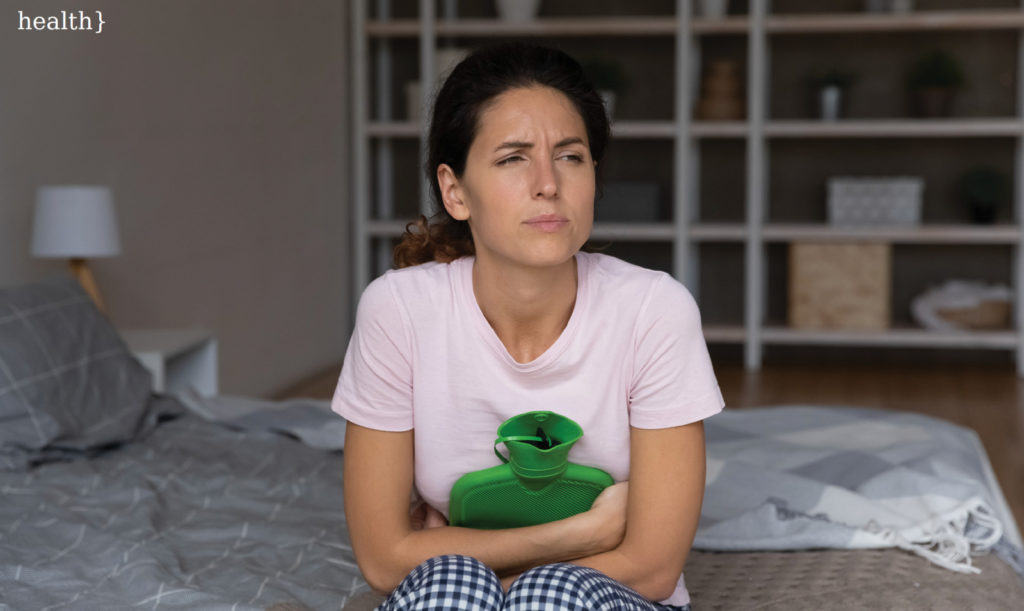Management of Heavy and Painful Periods
By Austin Rusher, WHNP

Have you ever had to leave work, or school, because period pain had you bending over or you were worried about saturating your clothes before you could make it to the bathroom? Or, even mild or bothersome pain associated with your period? Well, this article is for you friends! Oftentimes, patients present to our clinic with heavy and painful periods. Scenarios can range from a desire to know what is normal to a desperate call for help as relationships, mood, and even employment can be affected. Those that can relate to the latter, are picturing themselves curled up in the fetal position in bed, clutching a warming pad to their abdomen, and thinking about the mountain of period products’ cost hitting their bank account each month.
To begin, let’s talk about baseline interventions, this is a great place to start. The first baseline intervention – exercise. I can hear the groans coming from those currently curled up in the fetal position! In medicine, we love encouraging exercise. When we exercise endorphins are released and we can see both a reduction of painful symptoms and an improvement in our mood. Another great baseline intervention is heat therapy. It is simple in concept and utilization by helping to relax tense abdominal muscles. Using a rice heating pad or electrical heating pad are great heat therapy tools. Ideally exercise and heat, if not adequate on their own, can be paired with further necessary treatment, as described below.
First tier therapy takes us into the realm of drug therapy. We have a few options here. Over the counter, Nonsteroidal Anti-Inflammatory Drugs (NSAIDS) and Tylenol are both good initial options for pain relief. NSAIDs, such as Ibuprofen, have the added bonus of potentially lightening the menstrual flow by interfering with the cascade of prostaglandins associated with our cycles. Prostaglandins are the buggers responsible for causing our uteruses to contract (i.e. cramp) and shed our linings when the time is right. Medication therapy should be started the day before, or the day of your period for optimal results. Continuation for a few days is often necessary as symptoms persist, and as NSAIDS can be hard on the old gastro-intestinal system, they should be taken with food and caution.
Our next pharmacological option is the poorly titled category, in my opinion, birth control (BC). Hormonal BC is not just for the prevention of pregnancy. It is commonly used by individuals that are not sexually active or are not at risk for pregnancy. However, some of these individuals are suffering from painful, and or, heavy periods. There are actually numerous types of BC and mechanisms of action. Options are a good thing, and they allow us to cater our care to individual needs and symptoms. For the sake of the article, we will be discussing hormone containing BC.
To begin, let’s talk about baseline interventions, this is a great place to start. The first baseline intervention – exercise… Another great baseline intervention is heat therapy.
Oral contraceptive pills are what most people think of when they think about birth control and we have many options. Essentially, all birth control is a problem-solving method of trial and error. The true test of an individual fit, is by giving you, a unique and awesome individual, a trial run. Yes, skinny jeans are a popular style made for all body types, but they are not a preferred choice for numerous individuals for numerous reasons. Still, usually a person has to try them on to know for sure, or at least find out, why they are not a good fit. The same concept is true for birth control.
The goal with BC for heavy or painful periods, is essentially to regulate your cycle. This can often present as a “quieting down” of the process overall. Ideally, our cycles become more regular and predictable. BC can lighten the menstrual flow or get rid of it all together. Some of you are thinking “whoa, is that safe?” The answer in that scenario is, yes! Progesterone, one of the hormones in hormonal BC, acts, in part, to thin out the lining of your uterus and calm your reproductive-system down. Effectively, protecting the lining of your uterus from cancer. If you are not having a period, without a reason, you need to be evaluated further. Again, another topic for another article, or an appointment in our office!
Typically, we start with an Oral Contraceptive Pill (OCP) that needs to be taken every day at the same time. Missing pills, or not regularly taking them at the same time every day, can actually make our symptoms worse. Our cycles usually have a predictable rhythm and flow, and that can become out of tune if we are not routinely careful. I can hear theoretical laughter coming from those that understand themselves well enough to know that this would not be a good fit for them.
For those of us that would prefer, or more honestly, not be capable of such a strict routine, we have other options. These include the patch, vaginal ring-insert, shot, and Long Acting Reversible Contraceptive (LARC) methods. With the patch and vaginal ring, we decrease the daily mental load of remembering a pill every day, to remembering to replace the patch or ring every month. No procedure required, just set a monthly reminder in your notifications, or mark it on your calendar. A great option for a lot of people!
A short note on the shot. As with all people, this is an option that can work great for some people and not so great for others. It can thin the lining of your uterus, and actually stop ovulation, that is one culprit of pelvic pain associated with menstrual cycles but not menses. In doing so, it can lighten or halt your menses and quiet the reproductive cycle, effectively relieving both the heavy and painful aspects of periods. Unfortunately, the trial period is three months from injection, as it stays in your system that long. Also, the shot isn’t something you can give yourself, so you have to make appointments with your provider/clinic every three months to stay up-to-date on your medication.
Admittedly, I see a lot of benefits with the hormonal Long Acting Reversible Contraceptive (LARC) methods for the management of heavy and painful periods. One such LARC is an implant known as the Nexplanon, that is inserted into your arm under local anesthetic. Other great LARC options are hormonal Intrauterine devices (IUDs), which are inserted into the uterus, examples include Mirena and Kyleena.
LARC methods are great for people that would prefer to have a procedure at insertion and removal, rather than having to remember something every day, or even once per month.
The hormonal IUDs differ in size, amount of hormone contained, and approved length of efficacy. LARC methods are a progesterone only form of contraceptive that have benefits of being less overall hormone, and therefore, less negative hormone related side-effects. Their effectiveness, approved by the FDA, lasts three to six years from insertion. Also, I know that this is not the topic on hand, but they deserve a nod for being what we in the medical profession call “tier one birth control.” They are, at or over, 99% effective!
LARC methods are great for people that would prefer to have a procedure at insertion and removal, rather than having to remember something every day, or even once per month. As another benefit, and as the name implies, they are easily reversible. Once removed, the active ingredient, progesterone, is out of your system in a matter of hours. Ideally, LARC methods lighten or even halt your period, thereby relieving the painful and or heavy flow causing debilitating effects of periods that can be distressing.
With all of these options, BC should only be started after careful consideration, an individual analysis, and evaluation by a medical provider. Often times, the first visit to your providers office is just gathering information and learning more about available options. Part of the discussion should always include the risks, benefits, and instructions for use.
Luckily, painful periods and heavy bleeding can be effectively managed for most people. Call our office to schedule an appointment! We’re happy to discuss your concerns and help find the best period management option to fit your lifestyle, just like those elusive skinny jeans
Austin Rusher, WHNP joined Kalispell OB/GYN in December of 2020, returning to Montana to be closer to family. She received her nursing degree from Montana State University in 2012 and her degree as a Women’s Health Nurse Practitioner from Frontier School of Midwifery and Family Nursing in Hyden, Kentucky in 2020.
